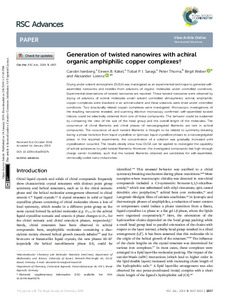Generation of twisted nanowires with achiral organic amphiphilic copper complexes
| dc.date.accessioned | 2019-02-05T13:28:40Z | |
| dc.date.available | 2019-02-05T13:28:40Z | |
| dc.date.issued | 2019-01-14 | |
| dc.identifier | doi:10.17170/kobra-20190204154 | |
| dc.identifier.uri | http://hdl.handle.net/123456789/11068 | |
| dc.description.sponsorship | Gefördert durch den Publikationsfonds der Universität Kassel | |
| dc.language.iso | eng | |
| dc.rights | Urheberrechtlich geschützt | |
| dc.rights.uri | https://rightsstatements.org/page/InC/1.0/ | |
| dc.subject.ddc | 540 | |
| dc.title | Generation of twisted nanowires with achiral organic amphiphilic copper complexes | eng |
| dc.type | Aufsatz | |
| dcterms.abstract | Drying under solvent atmosphere (DUSA) was investigated as an experimental technique to generate self-assembled nanowires and needles from solutions of organic molecules under controlled conditions. Experimental observations of twisted nanowires are reported. These twisted nanowires were obtained by drying of solutions of achiral molecules under solvent controlled atmospheres: achiral, amphiphilic copper complexes were dissolved in an achiral solvent and these solutions were dried under controlled conditions. Two structurally related copper complexes were investigated. Microscopic investigations of the resulting nanowires revealed, and scanning electron microscopy confirmed: self-assembled twisted ribbons could be selectively obtained from one of these compounds. This behavior could be explained by comparing the ratio of the size of the head group and the overall length of the molecules. The occurrence of chiral filaments and chiral phases of nanosegregated filaments are rare in achiral compounds. The occurance of such twisted filaments is thought to be related to symmetry-breaking during a phase transition from liquid crystalline or lyotropic liquid crystalline phases to a nanosegregated phase. In the reported experiments, the concentration of a solution was gradually increased until crystallization occurred. The results clearly show how DUSA can be applied to investigate the capability of achiral substances to yield twisted filaments. Moreover, the investigated compounds had high-enough charge carrier mobilities, such that the twisted filaments obtained are candidates for self-assembled, intrinsically coiled nano-inductivities. | eng |
| dcterms.accessRights | open access | |
| dcterms.creator | Isenberg, Carolin | |
| dcterms.creator | Käkel, Eireen B. | |
| dcterms.creator | Saragi, Tobat P. I. | |
| dcterms.creator | Thoma, Peter | |
| dcterms.creator | Weber, Birgit | |
| dcterms.creator | Lorenz, Alexander | |
| dc.relation.doi | doi:10.1039/c8ra09027k | |
| dc.type.version | publishedVersion | |
| dcterms.source.identifier | ISSN 2046-2069 | |
| dcterms.source.issue | 4 | |
| dcterms.source.journal | RSC Advances | |
| dcterms.source.pageinfo | 1807-1813 | |
| dcterms.source.volume | 2019, 9 |
Dateien zu dieser Ressource
Das Dokument erscheint in:
-
Artikel [1103]

